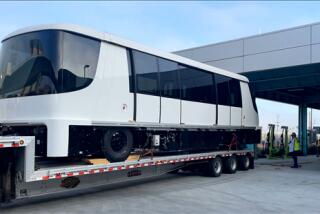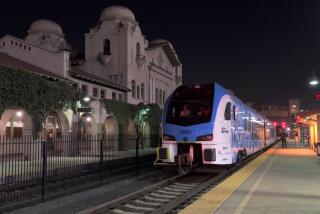S.F. Quietly Replacing Aged Cable Cars
SAN FRANCISCO â If Andrew Hallidie was the father of the San Francisco cable car, Freida Klussnann was its patron saint.
When Mayor Roger Lapham wanted to replace the cityâs cable fleet with motor coaches, Klussnann, an influential socialite, waged a successful ballot battle to stop the move. It was 1947, more than 70 years after Hallidie invented what became the cityâs most venerable symbol.
Today, a quieter effort is under way to preserve the top San Francisco tourist attraction, which lugs an estimated 11 million people a year up and down the cityâs steep, hilly streets.
The San Francisco Municipal Railway last month unveiled three new handmade cable cars, fashioned out of oak and Alaskan yellow cedar and meticulously adorned with brass details. Each car took 1 1/2 years to build.
The double-ended model built for the California Street line is the first constructed for the line since 1914; the other two, built for the Powell Street line, join cars put together as recently as 1986.
Tim Reilly, Muniâs pattern maker, used parts of old cable cars to design casts for bells, gongs, fixtures and hardware for the new ones because only bits and pieces of original blueprints had survived. He also made the stanchions, posts and rails.
âWe have pride in what we do because there are people from all over the world who get to see the work,â Reilly said.
Six carpenters work full time to replace and work on replacement parts for Muniâs 36 cable cars, some of which are about 100 years old.
The railway wants the aging cars off the streets before they become a threat to tourists.
âIt comes to a point where you canât patch and repair them anymore; youâve got to replace them,â said John Stenson, Muniâs cable car building supervisor.
Hallidie invented the cable car in 1873 especially for San Franciscoâs steep grades. They run on rails, pulled by a long steel cable moving about 9 m.p.h. in a slot beneath the street surface.
Other cities adopted cable cars but replaced them with electric streetcars.
Folklore has it that Hallidie, a Scottish immigrant, came up with the idea after he saw horses dropping from exhaustion from the steep climbs.
At its height in the late 1800s, the cable car fleet had between 500 and 600 cars that carried riders over more than 100 miles of track. Many of them were destroyed in the 1906 earthquake.
The modern fleet, by comparison, primarily transports tourists over a mere 10 miles of track, in exchange for $3.
If it hadnât been for Klussnann, the cable carâs journey might have ended in 1947. She started her ballot crusade after reading a Herb Caen column that discussed the mayorâs plan to scrap the fleet for a more modern mode of transportation. Klussnannâs measure got 77% of the vote, and the cable car became ingrained as a city symbol.
âCable cars are embedded into the history and fabric of our community, and we are very glad to see the new ones coming on line for all the residents and visitors to our great city to enjoy,â said Staci Walters, a spokeswoman for Mayor Frank Jordan.
The cars take in about $10.5 million a year, making them one of the cityâs top tourist attractions, said Muni spokesman Alan Siegel. When Muni closed the system from 1982 to 1984 for repairs and renovations, tourism dropped off as much as 10%, Stenson said.
The cars are relatively safe; the last major accident was in 1988, when one hit a utility truck and pitched a load of tourists into an intersection, injuring 27. The last death occurred nearly two decades ago on a runaway cable car, Stenson said.
But navigating through busy, modern-day streets is no easy task for the gripmen who operate the cars.
âYou have all these jaywalkers and cars cutting in front of you, and you have a primitive braking system, the same as they had 100 years ago,â Stenson said.
Muni plans to build 10 more cable cars in the next decade.
The time-consuming task is worth it, Stenson said: Each cable car costs about $195,000 to build and has a life expectancy of 65 to 100 years. Light rail vehicles, by comparison, cost $2 million each to build and last only 15 to 20 years, he said.
âDoing things the old-fashioned way,â Stenson said, âstill pays off.â
More to Read
Sign up for Essential California
The most important California stories and recommendations in your inbox every morning.
You may occasionally receive promotional content from the Los Angeles Times.










